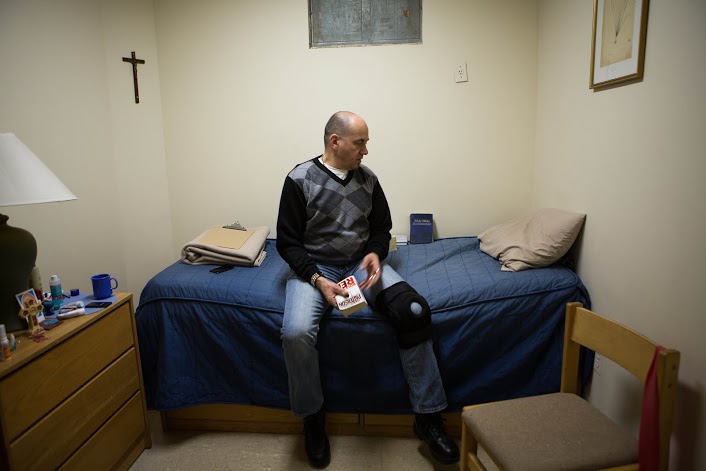
Homeless flock to shelters to brave snowiest winter in years
It was almost 7 a.m., and just 32 degrees. Sleet made the sidewalk slippery and bumpy.
Peter Rivera zipped his blue coat, put on gloves and picked up his belongings at the front desk of the St. Anthony Shelter for Renewal on E. 156th St. Rivera, 53, is homeless and was prepared to spend the day outside.
The city was hit by several storms in January. The minimum temperature was almost 8 degrees lower than in January 2013, according to the National Weather Service. When the temperature drops to 32 or lower, or during times of sustained winds and precipitation, the city’s Department of Homeless Services implements Code Blue, which means that it added more outreach teams and that homeless people may go to any of the agency’s adult facilities, including shelters and drop-in centers, without going through the usual intake process, which involves documentation.
Though the Code Blue rules were implemented citywide, Rivera and the other homeless people who stay at St. Anthony and at other private shelters still have to leave the shelter every morning, at 7, and must find other places to stay warm until 6:30 p.m.
“We don’t have the manpower the city shelters have,” said Louis Marie Leonelli, St. Anthony’s director. “We don’t have paid staff, we don’t have employees and we don’t have people full time working here.”
After walking seven blocks on Melrose Avenue, Rivera arrived at the McDonald’s at 3rd and Melrose. He and other homeless people usually hang out here, as well as in the emergency room of Lincoln Hospital, and it is the first spot Rivera visits every day.
“We all know each other,” Rivera said, pointing to a group of people sitting in a small booth, drinking their morning coffee. He said the restaurant staff was nice to them as long as they behaved politely and didn’t bother other customers.
According to the HOPE 2013 NYC Street Survey, an annual survey of those living unsheltered in the city, there were an estimated 3,180 unsheltered people, 82 fewer than in 2012. The number of homeless has dropped 28 percent since 2005, from 4,395.
Rivera bought a large coffee and returned to his booth. While waiting for a doctor’s appointment at 11 a.m., Rivera took out “Alex Cross’s Trial,” a book by his favorite author, James Patterson. He said reading and borrowing books from libraries are his way of killing time. He prefers the library to the McDonald’s at 3rd and Melrose, as he has access to the Internet and classes.
“I bring in once a month the updated schedule of what they offer for the guys,” Rivera said, suggesting the Kingsbridge library to others in the shelter.
Rivera has been homeless since almost a year. After his wife died, he struggled financially and had to sell his house in Westchester County. He was unable to work because of injuries he suffered while working in construction since last year, he said.
Before Rivera found a room in the Bronx last year, he stayed in a city-run shelter in Lower Manhattan for five days. Theft was a problem in the city shelter, prompting him to take his wallet into the shower with him in a zip-lock bag.

People staying in the St. Anthony sign an agreement to respect the rules, which include cleaning their own rooms every day, no tolerance of violence, no threatening language, no illegal objects and no alcohol. They agree to leave after six months, the maximum time allowed, Leonelli said. “That will give a man sufficient time to get his life back to order,” he said.
Though Leonelli can’t open the door to the homeless 24 hours a day, he said they can still stay in the shelter in extreme weather. Otherwise, unless St. Anthony residents are sick and have medical documentation, they are not allowed to stay in the shelter all day.
“I wish I could stay in some days,” Rivera said. “It’s especially uncomfortable when it snows because I have these issues with my back, my knees and my cervical so I have to be extra cautious.”
For volunteers at St. Anthony, asking people to leave is the hardest part of their jobs. “We can only house so many people in the shelter, so we had to turn a lot of people away,” said Mat Oelke, 28, a volunteer from Minnesota. “Maybe five to ten every day.”
After his doctor canceled the appointment, Rivera ended his day as usual, lining up in front of St. Anthony and waiting for the intake process. Before stepping into the shelter at 6:30 p.m., he took a Breathalyzer test and handed in his phone and metal belongings at the front desk, as usual.
“You can actually feel safe, ” said Oelke, adding feeling safe is key for people getting their lives back on track.


[…] Chen, working for the Mott Haven Herald, reported on how the homeless are braving the punishing winter. Emilie Pons wrote about a photo exhibit spotlighting the plight of girls forced to marry much […]